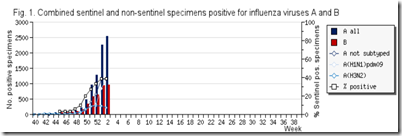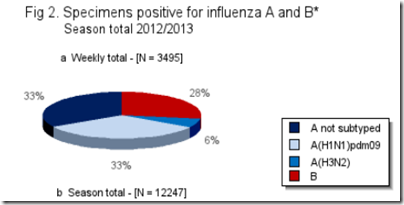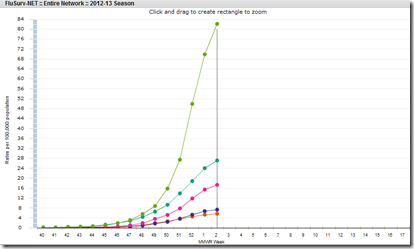Credit EuroFlu report Week 2
# 6867
Dominated by the H3N2 virus, the United States and Canada continue to see a worse than average flu season (see yesterday’s CDC FluView & Canadian FluWatch reports) – while reports from Europe remain a mixed bag, with many countries reporting H1N1pdm09 or Influenza B leading this year’s viral charge.
Regions where H3N2 predominates generally see a more severe flu season, which may help explain why Europe hasn’t been hit nearly as hard as has North America.
Some excerpts from this week’s EuroFlu Report.
Large variation in influenza activity across the WHO European Region
Summary, week 2/2013
Consultation rates for influenza-like illness (ILI) and/or acute respiratory infection (ARI) are now increasing in almost all countries in the Region.
However, influenza activity is still largely limited to the western part of the Region, where widespread transmission is being reported by most countries currently.
While influenza A(H1N1)pdm09, A(H3N2) and type B viruses are circulating in the Region, the proportion of influenza A(H1N1)pdm09 continues to increase, relative to influenza B and A(H3N2), and accounts for 84% of influenza A viruses subtyped.
The number of reported hospitalizations due to severe acute respiratory infection (SARI) is increasing slowly along with a rising proportion of patients testing positive for influenza.
Virological surveillance for influenza
The number of specimens testing positive for influenza in the Region continues to rise, mainly due to increasing detections in the western part of the Region. Overall, a total of 3495 specimens tested positive for influenza in week 02/2013, the majority of which, 2532 (72%), were influenza A (Fig. 1).
The proportion of influenza A(H1N1)pdm09 viruses relative to A(H3N2) continues to increase. In week 2, among 1363 influenza A viruses subtyped, 1151 (84%) were A(H1N1)pdm09 while 212 (16%) were A(H3N2)(Fig. 2a).
This presents a very different picture from the 2011/2012 influenza season when A(H1N1)pdm09 detections were rare. In the 19 countries testing 20 or more sentinel specimens, influenza positivity ranged from 11% to 68%, with a median of 45% (mean: 44%).
Since the beginning of the season (week 40/2012), 12,247 influenza viruses from sentinel and non-sentinel sources have been typed: 8250 (67%) were influenza A and 3997 (33%) influenza B (Fig. 2b). Of the influenza A viruses, 4475 were subtyped: 2945 (66%) as A(H1N1)pdm09and 1530 (34%) as A(H3N2). In addition, since week 40/2012, the lineage has been determined for 497 influenza B viruses: 454 (91%) belonged to the B/Yamagata lineage and 43 (9%) to B/Victoria.
In another telling difference between the North American flu season and Europe’s are the age groups being hospitalized for SARI (Severe Acute Respiratory Infection).
Here in the United States where H3N2 currently reigns, laboratory confirmed influenza hospitalizations are overwhelmingly for those 65 and older (see CDC FluView chart below).
Whereas in Europe it is those under the age of 4 making up the majority of hospitalized cases. Once again, a pattern we’d expect to see when H1N1 and influenza B are the most active strains.
Hospital surveillance for SARI
Hospitalizations due to SARI have increased slightly over the past few weeks along with an increase in the proportion of respiratory specimens from patients testing positive for influenza (Fig. 7). Overall, the great majority of cases reported have been in the age-group 0–4 years (see Country data and graphs for individual country data).
While North America is likely about half-way through its flu season, for many parts of Europe flu activity is just starting to ramp up.
Influenza is unpredictable, so we’ll have to wait to see whether their contrarian pattern of seeing mostly H1N1 & Influenza B cases continues throughout the rest of their flu season.




